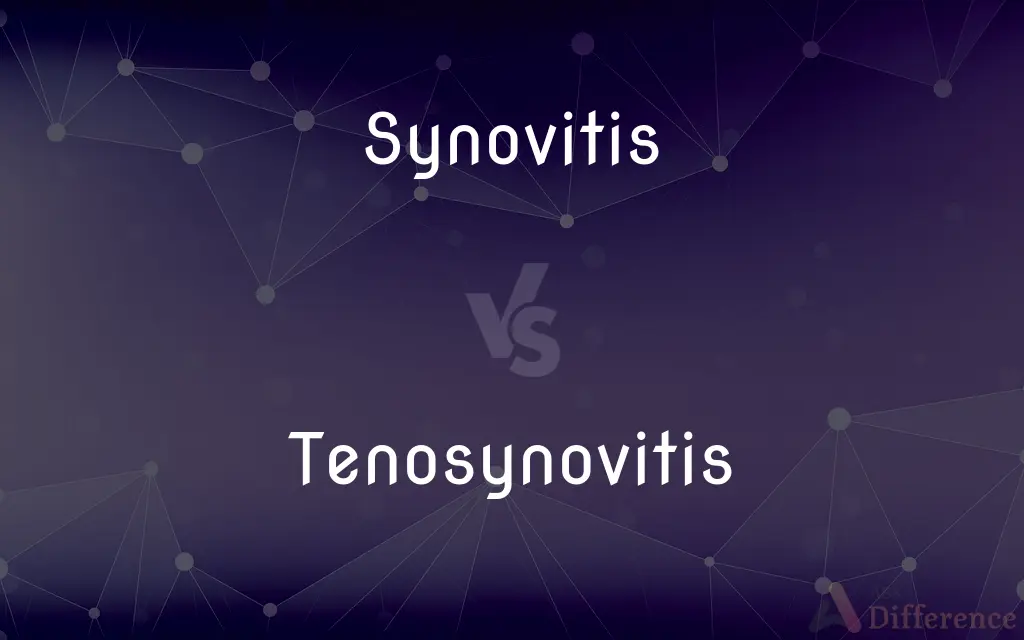Synovitis vs. Tenosynovitis — What's the Difference?
Edited by Tayyaba Rehman — By Fiza Rafique — Updated on April 15, 2024
Synovitis involves inflammation of the synovial membrane in joints, causing pain and swelling; tenosynovitis specifically affects the synovial sheath surrounding tendons, often resulting in movement difficulty.

Difference Between Synovitis and Tenosynovitis
Table of Contents
ADVERTISEMENT
Key Differences
Synovitis refers to the inflammation of the synovial membrane, which lines the joints such as the knee, wrist, and shoulder, leading to joint pain and swelling. Whereas tenosynovitis describes inflammation of the synovial sheath that surrounds a tendon, typically causing pain, swelling, and difficulty moving the affected tendon.
In synovitis, the inflammation can result from various conditions, including arthritis, injury, or infection, affecting joint function and comfort. On the other hand, tenosynovitis often stems from repetitive use or strain, infection, or an underlying rheumatic disease, specifically impacting tendon movements.
Patients with synovitis might experience generalized joint stiffness, especially after periods of inactivity, along with warmth and redness around the affected area. Whereas, in tenosynovitis, the symptoms are usually localized to the path of the tendon and may include a grating sensation or crepitus when moving the tendon.
Treatment for synovitis typically involves managing the underlying cause, using anti-inflammatory medications, and sometimes joint injections or aspiration. Conversely, tenosynovitis treatment may include immobilization of the affected area, corticosteroid injections, or surgery in severe cases.
Both conditions may benefit from physical therapy; however, synovitis therapy focuses on maintaining joint function and reducing inflammation, while therapy for tenosynovitis targets specific exercises to restore tendon gliding and alleviate constriction.
ADVERTISEMENT
Comparison Chart
Definition
Inflammation of the synovial membrane in joints.
Inflammation of the synovial sheath around tendons.
Common Causes
Arthritis, injury, infection.
Repetitive use, strain, infection.
Symptoms
Joint pain, swelling, stiffness, warmth, redness.
Pain, swelling along the tendon, difficulty moving, crepitus.
Affected Areas
Joints like knees, wrists, shoulders.
Tendons, often in wrists, ankles, fingers.
Treatment
Anti-inflammatory drugs, joint injections, aspiration.
Immobilization, corticosteroid injections, surgery.
Compare with Definitions
Synovitis
Can be acute or chronic.
Acute synovitis resolves with proper treatment, whereas chronic synovitis may require ongoing management.
Tenosynovitis
Inflammation of the synovial sheath around a tendon.
Repetitive wrist movements led to her developing tenosynovitis, making typing painful.
Synovitis
A joint disorder characterized by excess synovial fluid.
Synovitis often causes the joint to feel swollen and tight due to excess fluid.
Tenosynovitis
Often seen in hands and feet.
She noticed tenosynovitis symptoms in her fingers after extensive gardening.
Synovitis
Diagnosed via physical examination and imaging.
MRI scans are useful in diagnosing synovitis and determining its severity.
Tenosynovitis
Can lead to tendon sheath thickening.
Chronic tenosynovitis often causes the tendon sheath to thicken, restricting movement.
Synovitis
Commonly associated with autoimmune disorders.
Patients with rheumatoid arthritis frequently suffer from synovitis as part of their condition.
Tenosynovitis
Requires specific interventions like splinting or surgery.
Severe tenosynovitis in his thumb required surgical intervention to relieve the pain.
Synovitis
Synovitis is the medical term for inflammation of the synovial membrane. This membrane lines joints that possess cavities, known as synovial joints.
Tenosynovitis
May involve crepitus or grating sensation.
Moving his ankle produced a grating noise, a sign of tenosynovitis.
Synovitis
Inflammation of a synovial membrane.
Tenosynovitis
Tenosynovitis is the inflammation of the fluid-filled sheath (called the synovium) that surrounds a tendon, typically leading to joint pain, swelling, and stiffness. Tenosynovitis can be either infectious or noninfectious.
Synovitis
(pathology) Inflammation of the synovium.
Tenosynovitis
Inflammation of a tendon sheath.
Synovitis
Inflammation of the synovial membrane.
Tenosynovitis
(pathology) An inflammation of the fluid-filled sheath (the synovium) that surrounds a tendon.
Synovitis
Inflammation of the synovial membrane that lines a synovial joint; results in pain and swelling
Tenosynovitis
Inflammation of the synovial sheath of a tendon.
Tenosynovitis
Inflammation of the sheath surrounding a tendon
Common Curiosities
How is synovitis diagnosed?
Diagnosis typically involves clinical evaluation, imaging tests like MRI or ultrasound, and sometimes synovial fluid analysis.
What activities increase the risk of developing tenosynovitis?
Activities involving repetitive hand, wrist, or foot movements, like typing, playing musical instruments, or certain sports, can increase the risk.
Are there any specific tests for tenosynovitis?
Diagnostic methods include physical examinations, ultrasound, and MRI to assess inflammation around tendons.
What are the long-term effects of tenosynovitis?
If not adequately treated, it can lead to chronic pain, restricted movement, and tendon degeneration.
Can synovitis lead to permanent joint damage?
Yes, if left untreated, chronic synovitis can lead to permanent joint damage and deformity.
Is exercise recommended for someone with synovitis?
Gentle, non-impact exercises may be recommended to maintain joint function and reduce stiffness without exacerbating symptoms.
Is tenosynovitis contagious?
No, tenosynovitis is not contagious; it is an inflammatory condition related to the tendon sheaths.
Is synovitis always painful?
While pain is a common symptom, some cases may present more with swelling and stiffness than acute pain.
Can diet affect synovitis?
While diet alone cannot cure synovitis, anti-inflammatory foods may help reduce symptoms and complement medical treatments.
What preventive measures can be taken against synovitis?
Preventive measures include maintaining a healthy weight, regular exercise, and avoiding joint stress.
How quickly does tenosynovitis develop?
It can develop suddenly after intense activity or gradually with repeated use over time.
Can children develop tenosynovitis?
Yes, children can develop tenosynovitis, often due to high levels of activity or sports participation.
What types of professionals treat tenosynovitis?
Treatment may involve primary care physicians, rheumatologists, orthopedic surgeons, or physical therapists.
Share Your Discovery

Previous Comparison
Demonstrable vs. Demonstration
Next Comparison
Arose vs. RoseAuthor Spotlight
Written by
Fiza RafiqueFiza Rafique is a skilled content writer at AskDifference.com, where she meticulously refines and enhances written pieces. Drawing from her vast editorial expertise, Fiza ensures clarity, accuracy, and precision in every article. Passionate about language, she continually seeks to elevate the quality of content for readers worldwide.
Edited by
Tayyaba RehmanTayyaba Rehman is a distinguished writer, currently serving as a primary contributor to askdifference.com. As a researcher in semantics and etymology, Tayyaba's passion for the complexity of languages and their distinctions has found a perfect home on the platform. Tayyaba delves into the intricacies of language, distinguishing between commonly confused words and phrases, thereby providing clarity for readers worldwide.
















































